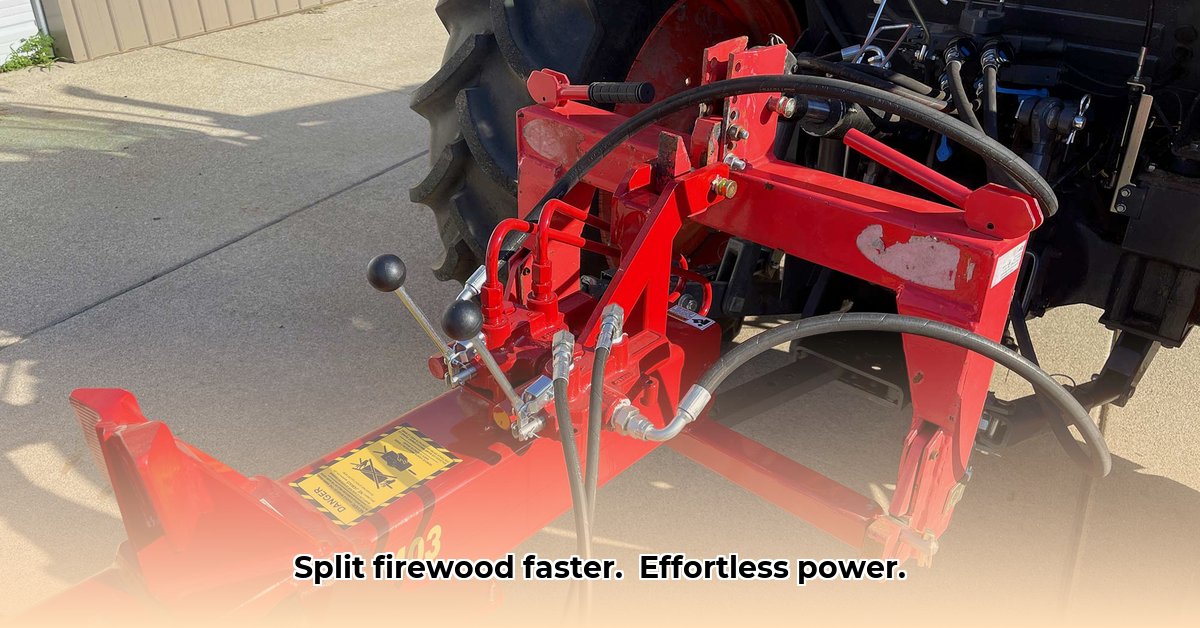
Understanding 3-Point Tractor Log Splitters: A Comprehensive Guide
Forget back-breaking manual labor! Three-point tractor log splitters dramatically increase firewood production, saving you significant time and effort. This guide covers everything from selecting the right splitter for your tractor to ensuring years of safe and efficient operation. We'll compare different splitter types, detail safety precautions, and explore future trends in this powerful technology. Whether you're a seasoned pro or a novice, this comprehensive guide will equip you with the knowledge to maximize your firewood production. For more options, check out these tractor supply wood splitters.
3-Point Hitch vs. PTO Splitters: Choosing the Right Power Source
Before selecting a specific model, understanding the two main types – 3-point hitch and PTO (Power Take-Off) – is crucial. Each offers unique advantages and disadvantages.
A 3-point hitch splitter utilizes your tractor's hydraulic system, offering powerful, efficient splitting. This system requires a tractor with sufficient horsepower (HP) and hydraulic flow (GPM, gallons per minute). It’s often preferred for larger operations due to its increased power and efficiency.
Conversely, a PTO splitter uses your tractor's PTO shaft for power, providing a direct mechanical connection. While typically less expensive initially, this method requires substantial tractor horsepower and a robust PTO system.
Here's a summary:
| Feature | 3-Point Hitch Splitter | PTO Splitter |
|---|---|---|
| Power Source | Tractor's hydraulic system | Tractor's PTO shaft |
| Tractor Needs | Sufficient horsepower & high GPM | High horsepower & robust PTO system |
| Setup Complexity | More complex; requires hydraulic connections | Simpler; direct PTO shaft connection |
| Maintenance | Potential hydraulic leaks; may need specialized repairs | Generally simpler maintenance; fewer moving parts |
| Cost | Typically more expensive initially | Usually less expensive initially |
Choosing the Right Splitter: A Step-by-Step Guide
Selecting the right 3-point tractor log splitter requires careful consideration. This step-by-step guide ensures you make an informed decision.
Step 1: Assess Your Firewood Needs: How much firewood do you need annually? This determines the required splitter tonnage (splitting force) and splitting speed. A small operation needs less power than a larger-scale firewood business.
Step 2: Check Your Tractor's Specifications: Consult your tractor's manual for its horsepower (HP) and hydraulic flow rate (GPM). Matching these specs to the splitter's requirements is crucial for safe and efficient operation. An underpowered system will result in slow splitting, potentially leading to damage.
Step 3: Consider Splitter Tonnage: This refers to the splitting force, measured in tons. Higher tonnage handles larger logs, but requires more power from your tractor. Choose a tonnage appropriate for your typical log size. Overestimating can lead to unnecessary expense, while underestimating will limit your capabilities.
Step 4: Evaluate Splitting Speed: Faster splitting means increased efficiency, especially beneficial in cold weather. However, bear in mind that faster speeds often require more powerful, and more expensive, systems.
Step 5: Prioritize Safety Features: Look for automatic log return mechanisms, wedge guards, and easily accessible emergency shut-offs. Safety should always be the top priority when choosing any power equipment.
Safe Operation: Prioritizing Safety When Using Your Log Splitter
Safety is paramount. Always:
- Read the Owner's Manual: Familiarize yourself with all operating instructions and safety features before use.
- Level Ground: Operate on stable, level ground to prevent equipment instability.
- Wear PPE: Use personal protective equipment (PPE), including safety glasses, hearing protection, gloves, and steel-toe boots.
- Proper Log Handling: Employ log handling tools to avoid hand injuries. Never force logs.
- Clear Work Area: Ensure the area around the splitter is clear of obstructions and bystanders.
Maintenance and Troubleshooting: Keeping Your Splitter in Top Condition
Regular maintenance extends your splitter's lifespan and efficiency. This includes:
- Hydraulic Fluid Checks (for 3-point hitch splitters): Regularly check and change hydraulic fluid levels as recommended by the manufacturer.
- Blade Sharpness: Maintain sharp splitting blades for efficient splitting. Dull blades require more power and increase the risk of jamming.
- PTO Shaft Lubrication (for PTO splitters): Regular lubrication prevents wear and tear.
- Leak Detection: Regularly inspect hydraulic lines for leaks (3-point hitch splitters) and address them promptly.
Market Overview: Trends and the Future of 3-Point Log Splitters
The demand for efficient firewood production is growing. Manufacturers are responding with innovative designs and enhanced safety features. Industry experts are also exploring more automated systems and sustainable materials. This growing market indicates a bright future for this increasingly important technology.
Conclusion: Streamlining Your Firewood Production
A 3-point tractor log splitter significantly boosts firewood production efficiency. By carefully considering your needs, selecting the right model, and prioritizing safety and maintenance, you'll enjoy years of reliable service. Remember, safety is paramount; always adhere to the manufacturer’s instructions.